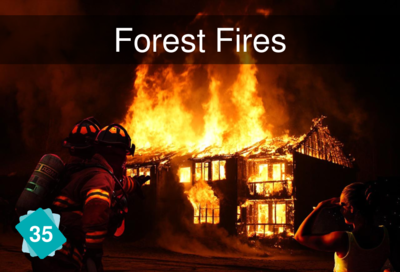En-en adult card 35 forest fires: Difference between revisions
(Created page with "{{Card |number=35 |version=adult |title=Forest Fires }} == Explanation ==") |
(move 35->38 to valid lingk) |
||
| (8 intermediate revisions by 2 users not shown) | |||
| Line 1: | Line 1: | ||
== Card #35: Forest Fires == | |||
<center> | |||
== | [[File:En-en_adult_card_35_front.png|400px]] | ||
Forest fires start and spread more easily during droughts and heatwaves. | |||
</center> | |||
== Correction== | |||
===Causes=== | |||
* [[En-en_adult_card_30_droughts|Droughts]] | |||
* [[En-en_adult_card_36_heat_waves|Heat Waves]] | |||
=== Consequences === | |||
* [[En-en adult card 38 human health|Human health]] 630 people died in Californian wildfires in autumn 2018. | |||
== Other possible links == | |||
=== Other consequences === | |||
* [[En-en adult card 6 deforestation|Deforestation]] Deforestation is partly done by burning the forest, which can then degenerate into uncontrolled fire. This is what happened in the summer of 2019 in the Amazon and Australia. | |||
* [[En-en adult card 10 aerosols|Aerosols]] Smoke from wildfires has been shown to carry toxic particles. | |||
* [[En-en adult card 25 terrestrial biodiversity|Terrestrial biodiversity]] This is a more minor link, except for specific biodiversity-rich areas. | |||
* [[En-en adult card 32 decline agricultural yields|Decline of agricultural yields]] Generally forests burn better than wheat fields. | |||
== To go further == | |||
=== Mega-Fire === | |||
A Mega-fire is an exceptionally large fire, causing large local fires that devastate expansive areas, without this appellation corresponding to a very precise scientific definition. We usually speak of a mega-fire when the affected area is at least 1,000 to 10,000 hectares. Mega-fires account for only 3% of all fires, yet represent 50% of global losses<ref>[https://books.google.fr/books?id=X8CnDwAAQBAJ&pg=PT12&lpg=PT12&dq=m%C3%A9gafeu+d%C3%A9finition&source=bl&ots=4mr41HwgSe&sig=ACfU3U1wsXSuuJ8L6hLmP_9Gu28cC4XI3w&hl=fr&sa=X&ved=2ahUKEwjfjK7Dro7nAhXl8OAKHQL_C8s4ChDoATAGegQIChAB#v=onepage&q&f=false Joelle Zask, When the Forest Burns: Thinking about the New Ecological Disaster (French)]</ref>. 96% of the last 500 mega-fires in the last 10 years took place during a period of abnormally high heat and/or drought<ref>[https://www.unenvironment.org/fr/actualites-et-recits/recit/les-megafeux-sont-ils-la-nouvelle-norme United Nations Are "megafires" the new standard? (French)]</ref>. | |||
=== Examples of events === | |||
In 2018, in California, 1,975,086 acres (799,200 hectares, about the size of Corsica) were burned, for a total of 8,000 fires and 100 casualties, but the burned area doubled in 2020 to reach 1,635,300 hectares (larger than Ile-De-France: the greater Paris area)<ref>[https://www.fire.ca.gov/incidents/2020/ 2020 Fire Season, Cal Fire]</ref>. | |||
In the 2019-2020 season, Australia saw a total area of 17 million hectares go up in smoke<ref>''[https://www.9news.com.au/national/australian-bushfires-17-million-hectares-burnt-more-than-previously-thought/b8249781-5c86-4167-b191-b9f628bdd164 Government set to revise total number of hectares destroyed during bushfire season to 17 million]''</ref>. This surface area represents a third of France. | |||
Forest fires on Mount Kilimanjaro on the rise<ref>[https://www.ipcc.ch/site/assets/uploads/2018/02/WGIIAR5-TS_FINAL.pdf AR5 WG2 IPCC, ''low confidence, major contribution from climate change'']</ref>. | |||
Forest fires on the rise in Portugal and Greece<ref>[https://www.ipcc.ch/site/assets/uploads/2018/02/WGIIAR5-TS_FINAL.pdf AR5 WG2 IPCC, ''low confidence, major contribution from climate change'']</ref> | |||
=== Article(s) === | |||
[http://bancpublic.net/article.php?id=5745 Fire the Earth, on the mega-fires (French)] | |||
== References == | |||
<references /> | |||
[[fr:Fr-fr_adulte_carte_35_incendies]] | |||
Latest revision as of 07:43, 3 November 2021
Card #35: Forest Fires
Forest fires start and spread more easily during droughts and heatwaves.
Correction
Causes
Consequences
- Human health 630 people died in Californian wildfires in autumn 2018.
Other possible links
Other consequences
- Deforestation Deforestation is partly done by burning the forest, which can then degenerate into uncontrolled fire. This is what happened in the summer of 2019 in the Amazon and Australia.
- Aerosols Smoke from wildfires has been shown to carry toxic particles.
- Terrestrial biodiversity This is a more minor link, except for specific biodiversity-rich areas.
- Decline of agricultural yields Generally forests burn better than wheat fields.
To go further
Mega-Fire
A Mega-fire is an exceptionally large fire, causing large local fires that devastate expansive areas, without this appellation corresponding to a very precise scientific definition. We usually speak of a mega-fire when the affected area is at least 1,000 to 10,000 hectares. Mega-fires account for only 3% of all fires, yet represent 50% of global losses[1]. 96% of the last 500 mega-fires in the last 10 years took place during a period of abnormally high heat and/or drought[2].
Examples of events
In 2018, in California, 1,975,086 acres (799,200 hectares, about the size of Corsica) were burned, for a total of 8,000 fires and 100 casualties, but the burned area doubled in 2020 to reach 1,635,300 hectares (larger than Ile-De-France: the greater Paris area)[3].
In the 2019-2020 season, Australia saw a total area of 17 million hectares go up in smoke[4]. This surface area represents a third of France.
Forest fires on Mount Kilimanjaro on the rise[5].
Forest fires on the rise in Portugal and Greece[6]
Article(s)
Fire the Earth, on the mega-fires (French)
References
- ↑ Joelle Zask, When the Forest Burns: Thinking about the New Ecological Disaster (French)
- ↑ United Nations Are "megafires" the new standard? (French)
- ↑ 2020 Fire Season, Cal Fire
- ↑ Government set to revise total number of hectares destroyed during bushfire season to 17 million
- ↑ AR5 WG2 IPCC, low confidence, major contribution from climate change
- ↑ AR5 WG2 IPCC, low confidence, major contribution from climate change
